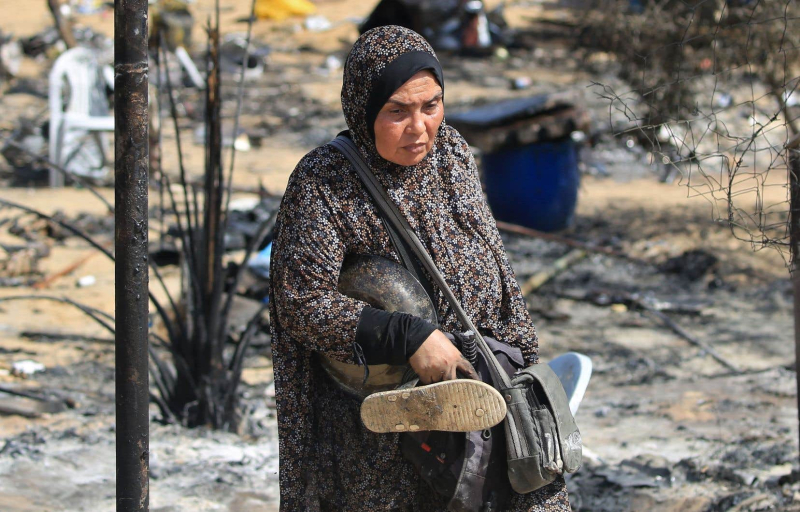
Photo: Eyad Baba Agence France-Presse Israeli troops launched a ground offensive on May 7 in the city of Rafah, then presented by Israel as the last major Hamas stronghold. But fighting has since intensified in several other regions, particularly in the north.
Agence France-Presse in Gaza
Published at 15:44
- Middle East
Fierce fighting pitted the Israeli army against Hamas fighters on Saturday in the north of the Gaza Strip, where the living conditions of residents are “disastrous” according to the UN agency for Palestinian refugees (UNRWA). .
The war, triggered by an unprecedented attack by the Islamist movement in Israel on October 7, has no respite across the Palestinian territory, and has raised fears of a conflagration in Lebanon.
Israeli troops launched a ground offensive on May 7 in the town of Rafah, then presented by Israel as the last major stronghold of Hamas. But the fighting has since regained intensity in several other regions, notably in the North.
Since Thursday, the Israeli army has been carrying out an operation in Choujaiya, an eastern neighborhood of Gaza City, where, according to her, “terrorist infrastructures” are located.
She said on Saturday that she had eliminated “dozens” of fighters there in 48 hours, reporting “close combat with terrorists”. In a statement, it added that it had discovered observation posts, weapons, drones and a rocket launch pad near schools and tunnel entrances.
The armed wings of Hamas and its ally Islamic Jihad indicated for their part that they were engaged in fighting with Israeli forces in the area.
The Palestinian Civil Defense reported “numerous deaths” and the flight of “tens of thousands of civilians” on Friday, after a call from the army to evacuate the neighborhood.
“Terrified”
“In the streets, people were panicking, they were terrified […] Everyone was leaving Shujaiya,” says Samah Hajaj. “It is not clear why [Israeli soldiers] entered Shujaiya since they had already destroyed the houses there. »
During the night and Saturday morning, AFP journalists heard explosions, airstrikes and gunfire coming from this area.
Also in Gaza City, Civil Defense reported that four bodies and six wounded had been extricated from the rubble of a building hit by an Israeli strike in the al-Sedra sector.
In the central Palestinian territory, residents cleared rubble in the Maghazi refugee camp after a nighttime strike on a house hit a medical center.< /p>
“The pharmacy, ophthalmology department and emergency department were completely destroyed. “All that's left is debris,” said Tarek Qandeel, director of the center.
Further south, five bodies were discovered after a bombing of displaced people's tents in the al-Mawasi sector, near Rafah, according to doctors.
The army continues operations in the latter town, bordering Egypt , saying they had eliminated “many terrorists”.
Witnesses reported deaths and injuries among the displaced from the Shakush camp, west of Rafah, after a new incursion by the Israeli army and shooting. A source at the Nasser medical center in Khan Yunis said they received four corpses from western Rafah.
The Hamas attack on October 7 in Israel resulted in the deaths of 1,195 people, mostly civilians, according to an AFP count based on official Israeli data.
32 hospitals damaged
During the attack, 251 people were kidnapped, of whom 116 are still being held in Gaza, among whom 42 are dead, according to the army.
Israel has promised to destroy Hamas, in power in Gaza since 2007 and which it considers a terrorist organization, as have the United States or the European Union.
Its offensive on the Gaza Strip has so far left 37,834 dead, mostly civilians, according to data from the Ministry of Health of the Hamas-led Gaza government.
The war has caused a humanitarian catastrophe in the small, besieged Palestinian territory of 2.4 million people, of which more than half have been displaced: water and food are lacking and the health system is on its knees.
A total of 32 hospitals out of 36 in the Gaza Strip have been damaged since October 7, and of these, 20 are now out of service, according to the World Health Organization (WHO).
A UNRWA mission officer, Louise Wateridge, described Friday as “disastrous” the living conditions in the Palestinian territory, where humanitarian aid is arriving in dribs and drabs.
Residents live in ruins of buildings or tents around a gigantic pile of waste, she told the press in Geneva, via video link from the center of the Gaza Strip.
Also read
- Gaza Civil Defense announces death of ten relatives of Hamas leader in strike
- Residents of northern Gaza Strip flee under Israeli bombardment
- American caregivers recount the horror in Gaza to put pressure on Washington
“No water, no food”
“There is no water, no sanitation, no food,” she added of Khan Younes, in the South.
Fears of seeing the conflict spread to the Lebanon have recently intensified with a verbal escalation between Israel and Hezbollah, an ally of Hamas.
Since October 7, the two camps have exchanged fire almost daily in the border area, with deadly violence having pushed thousands of residents on both sides of the border to flee.
Hezbollah ally Tehran warned Israel on Saturday that the “axis of resistance,” which includes Iran and its regional allies, could mobilize if it launched a “large-scale” offensive. in Lebanon.
On Wednesday, Israeli Defense Minister Yoav Gallant said that Israel did not want war with Hezbollah, but warned that his country had “the ability to return Lebanon to the Stone Age.”

